Mapping rules for land managers
Date published: 24 March, 2015
Table of Contents
- Overview
- Land parcels and maps
- Maps of your land on our system
- Disagreement over parcel area
- Maintaining the Land Parcel Information System
- When to submit a Land Maintenance Form
- Map requirements for existing applicants
- Map requirements for new applicants
- Special categories
- Rules for mapping land
- Examples of parcel boundary rules
- Download guidance
Overview
The Rural Payments and Inspections Division is responsible for keeping an accurate and up-to-date record of all land in Scotland being used for agriculture, forestry and other rural activities.
This is, in part, to make sure funding is allocated properly. So it’s vital you register your land with us and keep your information up-to-date as it could affect any funding claims.
The maps we create and maintain use Ordnance Survey MasterMap information for their core data.
Ordnance Survey MasterMap is a continually updated mapping database containing a variety of geographical features at a scale of 1:2500 to 1:10,000. Ordnance Survey updates the Mastermap database every six weeks and this can result in changes to the field boundaries on your IACS map.
The maps are for subsidy purposes, and must be maintained in-line with the rules dictated by the European Commission.
- you are required to map all of your agricultural land and any non-agricultural land that is in support of agri-environmental or forestry funding
- it is your responsibility to ensure the boundaries of your parcels are correct
If you need to amend the boundaries of your land parcels please complete a Land Maintenance Form and return it to your local area office.
Land parcels and maps
Our register of agricultural and forestry land parcels in Scotland is referred to as the Land Parcel Information System (LPIS). The system must have unique Land Parcel Identifiers and areas, against which all claims can be checked.
We hold the unique identifiers and gross areas for your land parcels on this register. This information is also on the maps we issue to you. You must use these unique Land Parcel Identifiers and areas when completing your Single Application Form.
Land located in other parts of the UK is subject to the land register system operated in that country.
Maps of your land on our system
We continually review the boundaries and ineligible areas within all land parcels held on the our register.
If you need to make a change to your land parcels you should complete and submit a Land Maintenance Form (PF06). You can download this (see Overview section above) or ask for a copy from your local area office.
It is important that you check the boundaries of your land parcels the map of your land we have on out system to ensure they are correct.
We have introduced aerial photography as a backdrop to our maps. Land parcels are identified by yellow boundaries with Land Parcel Identifiers and parcel gross areas listed in the table on the right hand side of the map.
Maps with aerial photography as a backdrop will only be issued when you notify us of changes to land parcels or a new map has to be issued.
The maps we previously issued show your land parcel boundaries in blue and black Ordnance Survey mapping (which shows roads, buildings, water features and general details) on a white background. Land Parcel Identifiers and land parcel gross areas are listed in the table on the right hand side of the map.
On both map types, the first column on the left hand side of the table shows a land parcel counter to identify the parcel on the map. The second column contains the unique Land Parcel Identifier and the third column lists the total gross area of the land parcel. You should use this to help you establish which Land Parcel Identifier belongs to each land parcel.
The claim you make using the Single Application Form is validated against our register. It is therefore essential that you use the most recent map sent to you to identify the land that you are claiming or declaring on your Single Application Form.
Your map shows the gross plan areas of your land parcel. They have been calculated on the assumption that the land parcel boundary is correct. These maps are for our purposes only and have no legal standing. They do not represent the ownership of the land.
Disagreement over parcel area
If you do not agree with the area shown on your map, you should first check whether the boundary of the land parcel is shown correctly following the Land Parcel Information System mapping rules in the section below. If not, then amend it by completing and submitting a Land Maintenance Form (PF06), which you can download (see Overview section above) or request from your local area office.
If you agree with the land parcel boundary shown, but are unhappy with the area, you can make your own arrangements to have the land professionally measured and to submit those measurements to us for approval. Any plans you submit under these arrangements should be surveyed and certified by an independent person who must hold a qualification from the Royal Institution of Chartered Surveyors (RICS), the Institution of Civil Engineers (ICE) or a similar professional body.
Any map you provide under these arrangements should be drawn to scale and clearly show the areas in question, the underlying Ordnance Survey Master Map detail and the Ordnance Survey map reference number.
Maintaining the Land Parcel Information System
It is important that the register is maintained and up-to-date.
It is your responsibility to ensure the register is correct by updating us of changes to boundaries and areas of land you manage.
If any land is bought or sold or boundaries change, you should update the register by completing and submitting a Land Maintenance Form (PF06), which you can download (see Overview section above) or request from your local area office.
It is in your interest to submit the form before 15 May with your Single Application Form, as any changes submitted after this deadline may delay your payment.
If you submitted a Land Maintenance Form for one or more of your land parcels previously and it is not yet fully processed, your pre-printed Single Application data sheets (which detail your land parcels) will not reflect any of this information.
Where your outstanding Land Maintenance Form relates to the boundary (and therefore the gross area of the land parcel), the pre-printed area in column D on your Single Application Form data sheets will be the original gross area printed on the map we sent you.
Unless you are confident that a different area will supersede the pre-printed area, use the pre-printed area as the total area of your land parcel, or the pre-printed areas as the potential eligible area.
If you claim less than this, do not amend the pre-printed area, but enter the correct area claimed in the appropriate data sheet column.
If you claim more than the pre-printed area and the results of your Land Maintenance Form do not substantiate a larger area, we may have to apply penalties.
If an Agri-Environment Climate Scheme or Forestry Grant Scheme measure exists in the land parcel you may have to adjust the pre-printed areas.
It is your responsibility to ensure the accuracy of the area you claim.
When to submit a Land Maintenance Form
You should submit a Land Maintenance Form in the following situations:
- when land is bought or sold
- when land is transferred from one holding to another for any reason other than change of owner
- when changes are made to the permanent boundary of a land parcel
- when internal boundaries are removed and land parcels are merged
- when internal boundaries are inserted and a land parcel is split
- when a land parcel is being registered for the first time
The Land Maintenance Form can be submitted either by the owner of the land parcel or by the long-term tenant on whose Single Application Form it appears.
Seasonal tenants should arrange for the owner or long-term tenant to submit a Land Maintenance Form. An agent can also submit a form on behalf of the owner or long-term tenant providing they have been authorised to do so.
Map requirements for existing applicants
When submitting a Land Maintenance Form with land parcel changes, you should supply a map with the details of every change clearly shown. If you have an existing map, you must use it to notify changes. Do not use correction fluid when altering your boundaries. Mark crosses on the line to be altered and (clearly) make any amendments in ink other than blue, or yellow for maps with aerial photography as the backdrop.
If you have a new land parcel that has not been registered, draw the boundaries clearly on your existing map. Check if the previous owner or occupier has already received a new unique Land Parcel Identifier and use this number. If the land parcel cannot be drawn on the map, supply another map showing the land parcel.
The map should be an Ordnance Survey map (or a professional equivalent) at 1:2500 (maps at 1:10,000) for land parcels up to 2000 hectares, and 1:10,000 (maps at 1:25,000) for land parcels above 2000 hectares. Make sure that the map sheet reference is marked on the map.
If you purchase or sell a land parcel which has already been registered you should enter the unique Land Parcel Identifier on the Land Maintenance Form showing the type of change, date of change, area etc. You do not need to submit a map if the boundaries have not changed.
Map requirements for new applicants
Requirements differ depending on the size of the land parcel that needs to be registered.
When submitting a Land Maintenance Form to register your land for the first time you should supply the following types of map:
- for a new land parcel up to 2000 hectares, you must submit an Ordnance Survey map at a scale of at least 1:2500 (maps at 1:10,000 scale are also acceptable), or a professionally produced equivalent
- for a new land parcel above 2000 hectares, the map should be at a scale of at least 1:10,000 (maps at 1: 25,000 scale are also acceptable)
Your map(s) must include:
- the code number of the holding
- for each land parcel, the land parcel boundary in blue and the estimated area in hectares. We cannot accept areas listed in acres. To convert from acres to hectares divide by 2.47
- for each land parcel, the reference number which you have used on your data sheet (if a Land Maintenance Form is submitted along with a Single Application Form)
Special categories
Common grazings
The grazings clerk or other appointed person should submit a Land Maintenance Form relating to changes to the common grazing. Forms relating to apportionments from the common grazing must only be submitted once the apportionment has been officially approved and a final order produced by the Crofter’s Commission.
Only common grazings not previously declared require a new map. If you are submitting a Single Application Form for the first time and you use a common grazing as part of your forage area, then we require a map of 1:25,000 scale covering the whole common grazing. Your application will not be processed until the map is supplied. Since only one map of the grazing is necessary, you may wish to arrange with others who share in the common grazing for this to be submitted to the relevant area office by the township clerk, grazing constable or other suitable person on behalf of the township, sheep stock club or grazings committee.
The boundary of the common grazing should be marked on the map and the person who submits the map should sign it on behalf of all shareholders. The map should show (or be accompanied by) a list of all shareholders with their allocated shares. Any apportionments granted should be clearly marked on the map and the map and the area of the common grazings (excluding apportioned land) should be marked in hectares. If you are having difficulties supplying a map or identifying apportionments please consult your local area office, who will advise on appropriate sources of information.
Closed agri-environment and forestry schemes
A Land Maintenance Form is required and a Land Parcel Identifier given if an area has never previously been captured and is not part of an existing land parcel.
A Land Maintenance Form will be accepted and a Land Parcel Identifier given if the area is part of an existing land parcel, over 0.01 hectares and fenced-off from the remaining area of the land parcel, but only where the area is to be permanently enclosed, for example an area to be managed under an agri-environment scheme.
A Land Maintenance Form is not required when the area is part of an existing land parcel already covered by a unique Land Parcel Identifier and under 0.01 hectares, whether fenced off or not.
Scottish Rural Development Programme
When registering land for the first time for Scottish Rural Development Programme purposes, an individual Land Parcel Identifier will not be allocated to buildings, car parks, paths, roads, areas of water over one hectare, sand or rocks. When completing a Land Maintenance Form for other new land parcels, the above should be excluded from the land parcel.
If you are registering land for the first time ensure where practical that these areas are not included in the land parcel.
Rules for mapping land
A. Mapping rules
1. All land parcel boundaries new and old must be clearly identifiable on the ground.
2. If the current parcel boundary is on an identifiable feature (permanent stock-proof or otherwise) it can remain there, provided there are no internal permanent stock-proof boundaries.
3. The minimum size of a Basic Payment Scheme land parcel is 0.1 hectares.
4. The first permanent stock-proof boundary encountered will normally become the parcel boundary, subject to other mapping rules.
5. Where the parcel boundary is moved onto an identifiable feature inside an existing boundary, the area of land between new and old parcel boundary has to be either made a new land parcel or unregistered land (that is, if it is less than 0.1 hectares in area, is not definable or is not used for agriculture).
New parcel
6. When the area between the new and old parcel boundary is made a new land parcel then the eligibility must also be addressed and recorded, as follows:
- if totally ineligible for the Basic Payment Scheme but actively managed for a Scottish Rural Development Programme scheme (excluding LFASS) it requires a separate parcel down to a minimum of 0.01 hectares with a Basic Payment Scheme exclusion for the whole area
- when the land is ineligible for the Basic Payment Scheme and not actively managed under agri-environment or forestry schemes it must be left as unregistered land
Internal features not touching the parcel boundary
7. For internal features not touching the parcel boundary:
- fenced Basic Payment Scheme ineligible areas within the parcel should be made unregistered land, for example a fenced house or garden site or fenced RYB. The minimum area for unregistered land is 0.01 hectares
- internal sites undefined by a physical boundary, for example unfenced buildings, water tanks or hard standing, should always be made Basic Payment Scheme exclusions, with a minimum individual or multipart exclusion area of 0.01 hectares
- internal eligible sites that are completely defined by a physical boundary (e.g. fence) and have an area greater than 0.1 hectares should become a separate new parcel
Fenced-off ditches
8. If the land parcel has a boundary on a ditch and there is a permanent stock-proof fence on the inside of the ditch that the boundary is moved on to, then:
- if managed for a Scottish Rural Development Programme scheme (excluding LFASS) the area between the ditch and fence must become a land parcel with its own Land Parcel Identifier and the eligibility must be assessed
- if not managed for a Scottish Rural Development Programme scheme, the area is greater than 0.1 hectares and it is eligible for the Basic Payment Scheme, then it should become a land parcel with its own Land Parcel Identifier, or unregistered land if not eligible for the Basic Payment Scheme
Double-fenced hedges
9. For double-fenced hedges:
- if the parcel boundary is on the centre of the hedge and the total width to the fences is less than six metres (three metres in each parcel) there is no boundary change required
- if the parcel boundary is on the centre of the hedge, it is greater than three metres to the protecting fence and claimed under a Scottish Rural Development Programme scheme, the area should become a separate parcel with a full Basic Payment Scheme exclusion
- if the parcel boundary is on an existing fence and the whole hedge is in the parcel, do not move boundary but make the whole internal hedge a Basic Payment Scheme exclusion if greater than three metres wide
Dykes
10. For dykes:
- a dyke itself is eligible for the Basic Payment Scheme up to a maximum width of three metres
- if a fence is greater than one metre from the dyke, the fence is the parcel boundary
Water
11. For water:
- an area of water greater than one hectare should be unregistered land
- an area of water less than one hectare, but greater than 0.01 hectares should be a Basic Payment Scheme exclusion
- where there are mosaics of water that are predominantly less than 0.01 hectares a technical assessment of the Basic Payment Scheme eligibility should be carried out
Trees
12. For trees:
- a fenced area of woodland and forestry greater than 0.1 hectares in area should become a new land parcel and the Basic Payment Scheme eligibility assessed. Woodland parcels should not be split due to internal boundaries
- for fenced woodland and forestry with an area less than 0.1 hectares but greater than 0.01 hectares, and claimed under a Scottish Rural Development Programme scheme (but not LFASS), a new land parcel should be created and a Basic Payment Scheme exclusion should be applied to the whole area
- for fenced woodland and forestry, on the parcel boundary, less than 0.1 hectares, and not claimed under a Scottish Rural Development Programme scheme, the area should be made unregistered land
- for fenced woodland and forestry, not on the parcel boundary, less than 0.1 hectares, and not claimed under a Scottish Rural Development Programme scheme, the area should have an Basic Payment Scheme exclusion applied, where applicable
- for unfenced woodland and forestry open to field, Basic Payment Scheme eligibility should be assessed
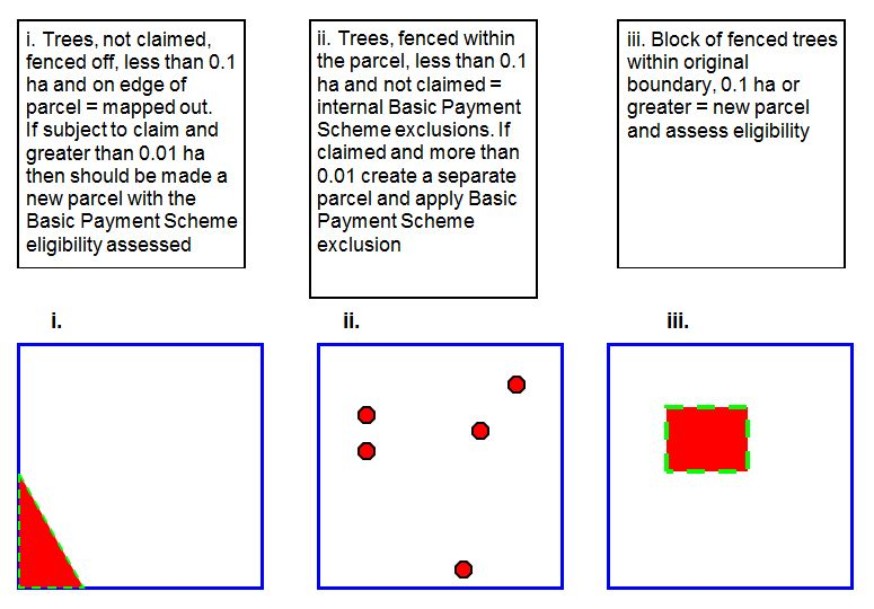
Foreshore and coastline
13. For foreshore and coastline:
- if the foreshore or coastal area is greater than 0.1 hectares, has identifiable boundaries all round and has eligible land cover, it can be made a land parcel. The Basic Payment Scheme eligibility within it must be assessed
- where there is no fenced boundary the new parcel boundary will be the end of the vegetative cover at the top of the cliff. If it is considered that there is utilisable vegetation beyond, the furthest point the boundary can be made from the vegetative line will be the high water mark and no further. The area between the vegetative line and the high water mark must be accompanied by a technical assessment of Basic Payment Scheme eligibility
B. Considerations when amending a boundary
Once a new parcel boundary has been established, the area beyond that boundary must be considered and will either be:
A new parcel
- if the area's main purpose is agricultural
- if definable on all sides
- if it achieves the minimum parcel size (which for the Basic Payment Scheme and LFASS is 0.1 hectares)
- if a parcel is under active agri-environmental management and smaller than 0.1 hectares then a new parcel must be created (although it will be ineligible for the Basic Payment Scheme and LFASS)
An amendment to the neighbouring parcel
- if the neighbouring parcel is also incorrect and the new boundary serves as the boundary for both parcels
Created as unregistered land
- if area is less than 0.1 hectares, has undefined boundaries, and / or is considered to be out of agriculture use
Please see examples C and below where the boundary has been moved to an internal fence and where the area beyond that must be considered to establish if it meets the criteria to become a new parcel or should become unregistered land.
Examples of parcel boundary rules
Example A: Internal ineligible features
The aerial photograph below shows an internally-fenced non-agricultural area, two small unfenced buildings and an unfenced track leading to the parcel boundary (blue line).
- the fenced non-agricultural area should be made unregistered land
- exclusions should be applied to the unfenced track and two small buildings (if ineligible area is greater than 0.01 hectares)
This is an example of mapping rule 7.

Example B: Internal ineligible features
- for non-agricultural features, such as the derelict building in photograph below, that are found within a parcel and not defined by a physical boundary, such as a fence, a Basic Payment Scheme exclusion should be applied to the area
This is an example of mapping rule 7(b).

Example C: Fenced-off tracks
New parcels must not be created for fenced-off tracks. Fenced tracks that are purely created as access from one point to another are not deemed as agricultural parcels.
These areas must become unregistered land, so a Land Maintenance Form must be submitted to remove parcel.
This is an example of mapping rule 6.
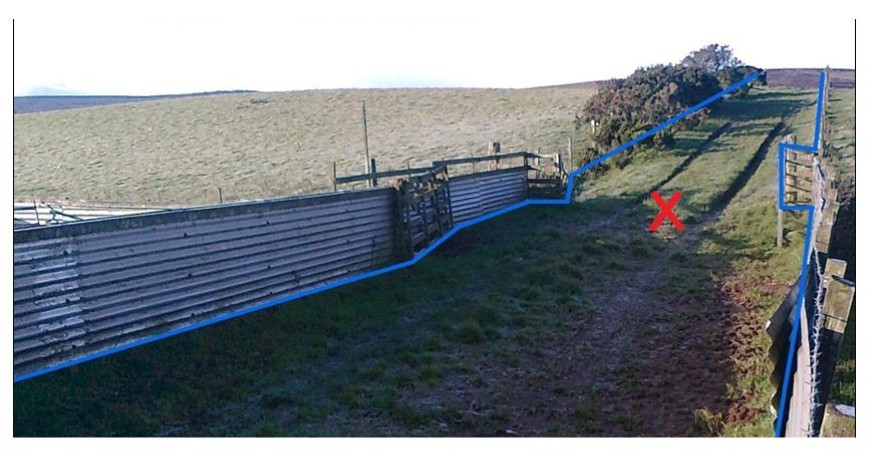
Example D: Double-fenced ditches
New parcels must not be created for double-fenced ditches, (unless under agri-environmental management).
Double-fenced ditches that are purely created to prevent access to the watercourse from one point to another are not deemed as agricultural parcels.
These areas must become unregistered land, so a Land Maintenance Form must be submitted.
This is an example of mapping rule 8.
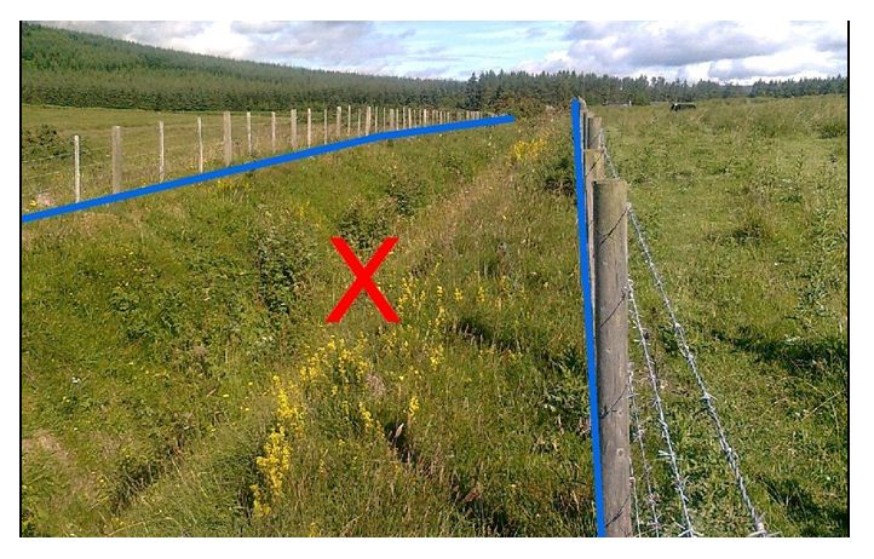
Example E: Domestic garden sites
New parcels must not be created for domestic garden sites. These areas are not deemed as agricultural parcels. These areas must become unregistered land so a Land Maintenance Form must be submitted.
This is an example of mapping rule 6.
Land owners and managers may wish to use these areas for grazing, but this land does not meet the definition of an agricultural parcel, and cannot be used to support a subsidy claim.
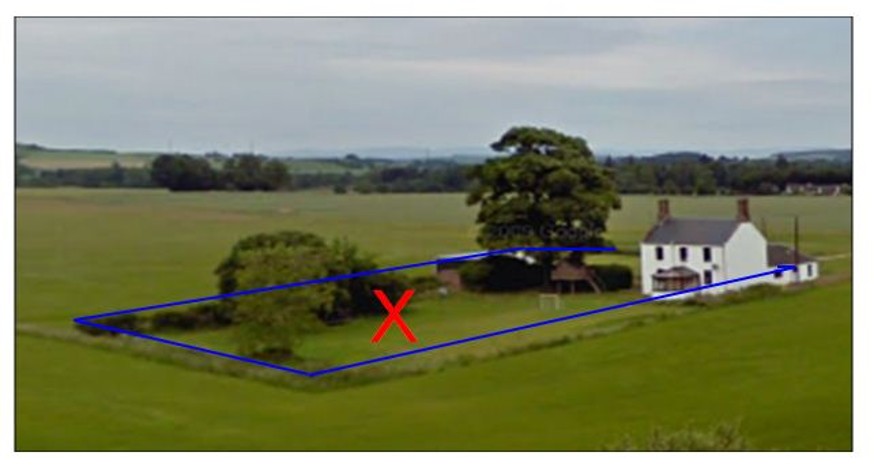
Example F: Parcel boundary is a dyke
As the fences are up against the dyke, if you find that there is only one Ordnance Survey line then the boundary can be left where it is.
This is an example of mapping rule 10.

Example G: Parcel boundary is on the centre of the hedge
Where you find a protected hedge that is currently the parcel boundary and the protecting fence is within three metres of the centre of the hedge then ignore the fence.
This is a United Kingdom derogation granted by the European Commission that allows newly-established hedges that will form the boundary time to mature.
Where the distance is greater than three metres then the fence must be mapped and the area beyond it considered. If the hedge is currently paid for under an agri-environment scheme then the area must be given its own Land Parcel Identifier, so a Land Maintenance Form must be submitted.
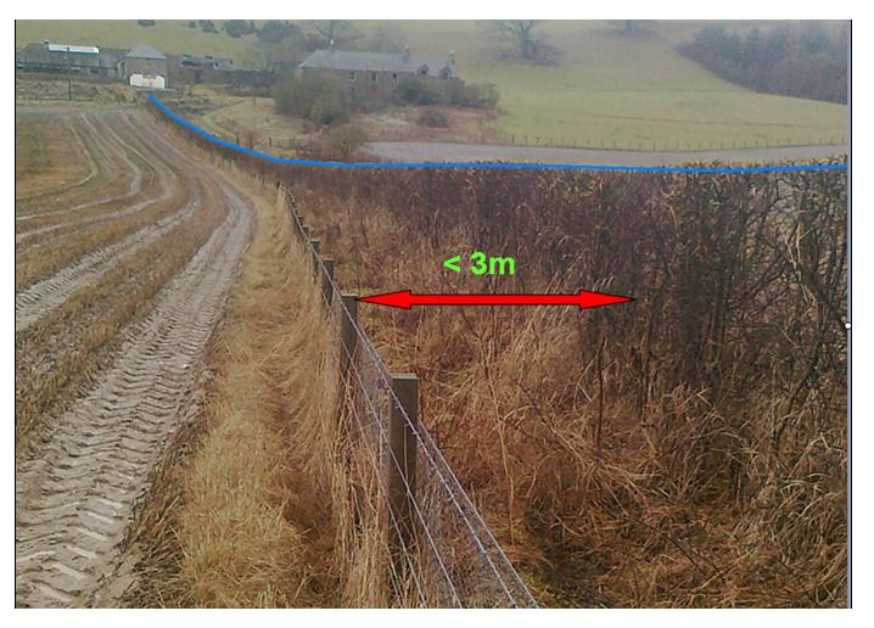
Example H: Internal stock-proof fence (1)
In this case, the current parcel boundary is on the right, on the far-left dyke.
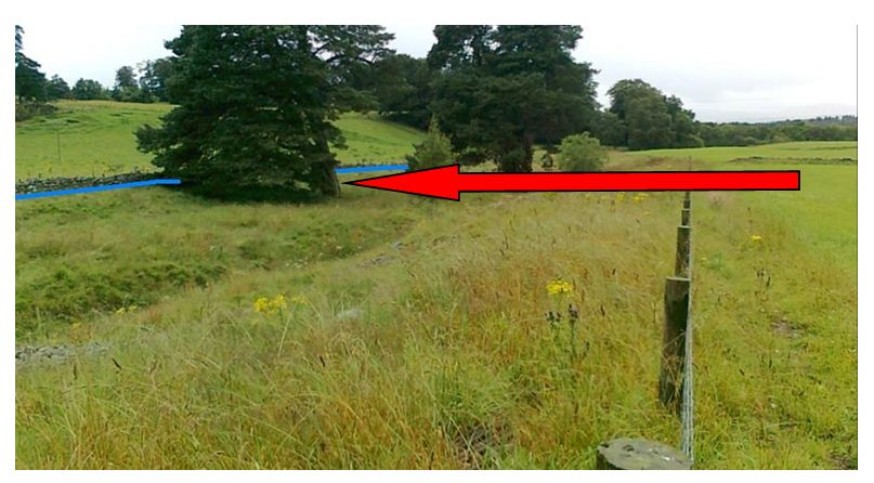
Working from the centre of the field outwards, as there is an identifiable boundary a new Land Parcel Identifier must be created along the fence. So a Land Maintenance Form must be submitted.
This is an example of mapping rule 4.
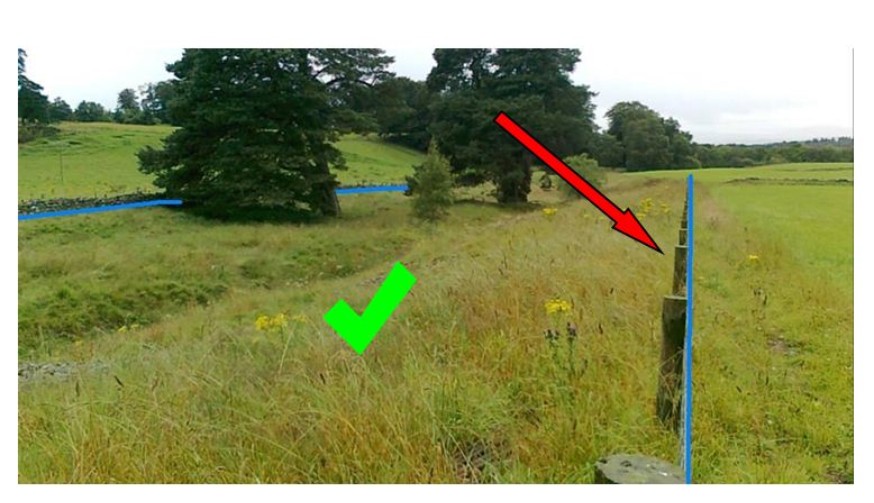
The area between the old and new parcel boundary must be considered now to see if it can be deemed an agricultural parcel. This is an example of mapping rule 5.
- is the area's main purpose agricultural? Yes
- does it have a definable boundary on all sides? Yes
- is it greater than 0.1 hectares in size? Yes
- is it under current agri-environmental management? n/a
In this case the area is used for agriculture, it is greater than 0.1 hectares and has a clearly identifiable boundary, therefore the area becomes a new Land Parcel Identifier. This should be requested in the Land Maintenance Form submitted to move the boundary.
Example I: Internal stock-proof fence (2)
In this case, the parcel boundary, for the parcel on the left, is on the edge of the road.
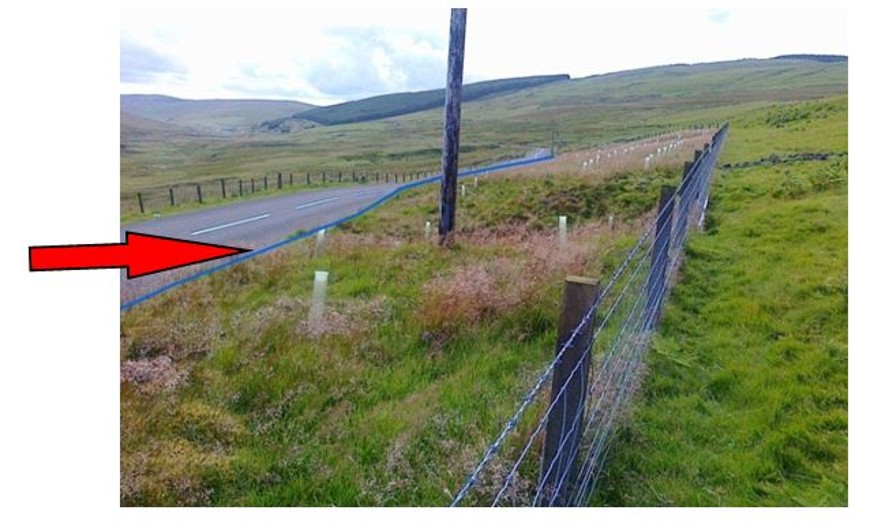
Working from the centre of the field outwards, as there is an identifiable boundary a new Land Parcel Identifier must be created along the fence and so a Land Maintenance Form must be submitted.
This is an example of mapping rule 4.
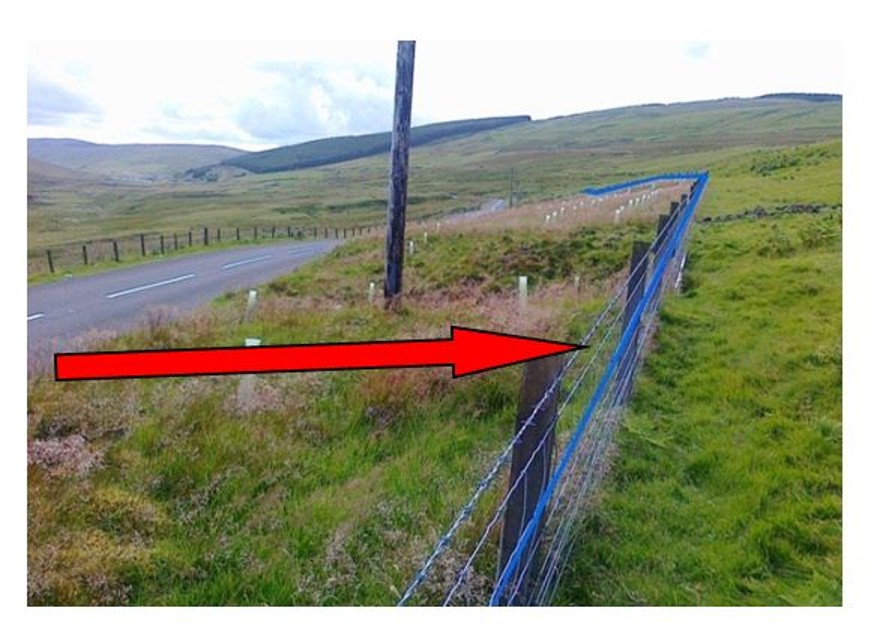
The area between the old and new land parcel boundary must be considered now to see if it can be deemed an agricultural parcel.
This is an example of mapping rule 5.
- is the area's main purpose agricultural? No
- does it have a definable boundary on all sides? No
- is it greater than 0.1 hectares in size? n/a
- is it under current agri-environmental management? No
In this case the area is non-agricultural land as it is a roadside verge and it does not have a definable boundary on all sides. Therefore this area will become unregistered land. In the Land Maintenance Form submitted to move the boundary, you should ask to have the area between the new boundary and the old boundary made unregistered land as it does not meet the criteria to be a land parcel.
Example J: Internal stock-proof fence (3)
In this case, the Land Parcel Identifier boundary (blue line) is on the water’s edge.

Working from the centre of the field outwards, there is a stock-proof boundary that protects a managed water margin (red line).
This is an example of mapping rule 4.
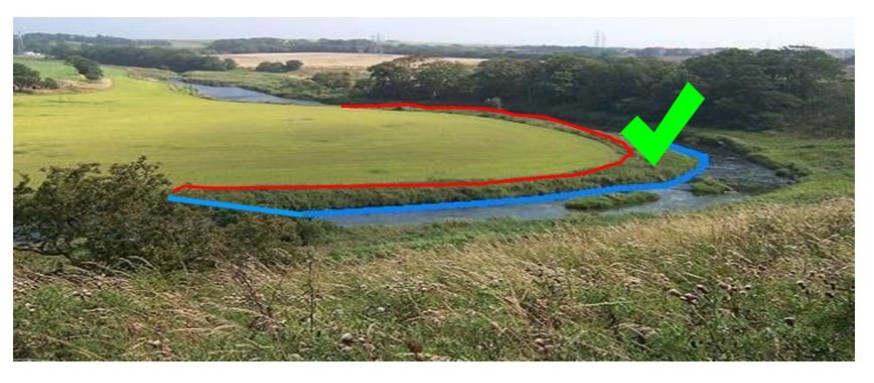
As the red line is a stock-proof boundary, it must be mapped as the new parcel boundary. This is an example of mapping rule 5. Therefore the area beyond it must now be considered.
- is the area's main purpose agricultural? No
- does it have a definable boundary on all sides? Yes
- is it greater than 0.1 hectares in size? n/a
- is it under current agri-environmental management? Yes
In this case the area is not agricultural but is part of the agricultural business's agri-environmental management scheme, therefore a new Land Parcel Identifier should be created for the area between the red and blue lines and a Land Maintenance Form submitted.
Example K: Double-fenced hedge
In this case, the Land Parcel Identifier boundary is on the original fence (right-hand side).
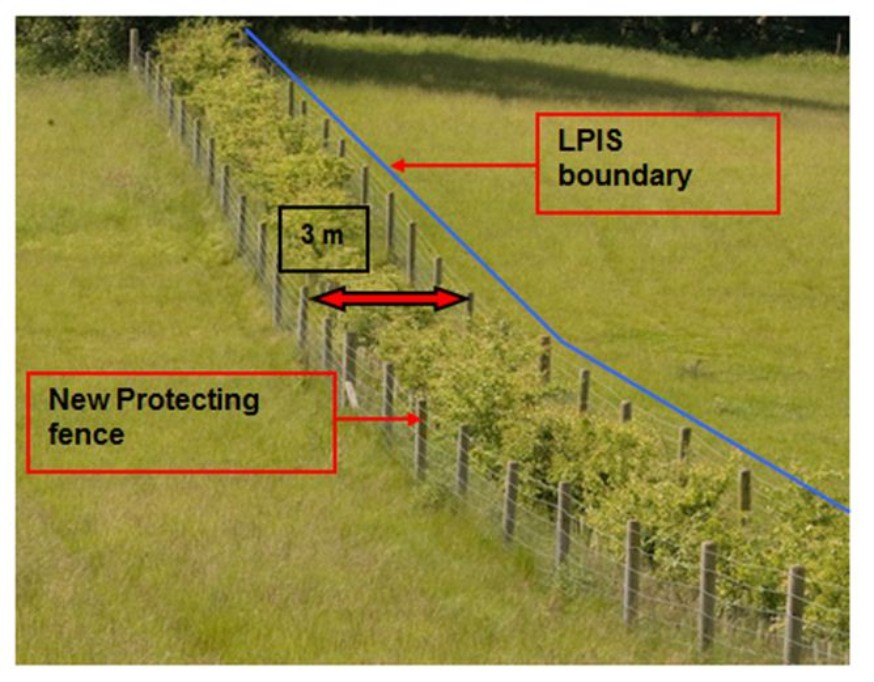
Where you find a protected hedge that is against the land parcel boundary and the protecting fence is within three metres of the boundary then ignore the protecting fence.
Where the distance is greater than three metres then the fence must be mapped and the area beyond it (the hedge area between the two fences) considered. If the hedge is currently paid under the Agri-Environment Climate Scheme, then the area must be given its own Land Parcel Identifier, so a Land Maintenance Form requires to be submitted.
If not part of a Scottish Rural Development Programme scheme, it should be made unregistered land.
These are examples of mapping rule 9.
Summary of the Land Parcel Information System boundary rules and protected hedges

Download guidance
Click 'Download this page' to create a printable version of this guidance that you can save or print out.
